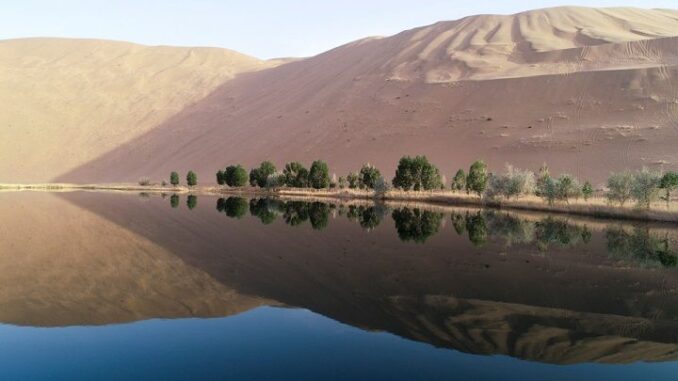
New Chinese inclusions in World Heritage List known for ‘valuable, vulnerable ecosystems’.
After around seven years of preparation, China’s Badain Jaran Desert – Towers of Sand and Lakes has finally been included on UNESCO’s World Heritage List. Another addition to the list is the Migratory Bird Sanctuaries along the coast of the Yellow Sea – Bohai Gulf (Phase II), which are distinguished for their role as “valuable and vulnerable ecosystems,” Zhang Yujun, professor and director of the National Park Research Center of Beijing Forestry University, told the Global Times.
The two sites’ world-heritage titles were awarded at the recent 46th session of the UNESCO World Heritage Committee in New Delhi, India. With their inclusion, China now has 15 Natural World Heritage sites, the most of any country in the world.
Located on the Alxa plateau in North China’s Inner Mongolia Autonomous Region, the Badain Jaran Desert – Towers of Sand and Lakes boasts “irreplaceable natural features,” such as the world’s tallest stabilized sand dunes, some rising 460 meters high, Liang Baorong, director of the Alxa Right Banner Administration Bureau of the Alxa Desert UNESCO Global Geopark, told the Global Times.
The site goes beyond just sand dunes as it covers different biomes such as desert and lakes that merge into one landscape. It is also the third-largest desert in the country. Varied microbial and sa-linities communities not only color its 144 inter-mountain lakes, but also provide a biodiverse habitat for birds, mollusk and fish.
“It is common to see wild ducks, cormorants and swans here,” Liang told the Global Times, not-ing that these creatures’ populations have been increasing in recent years.
Noting the site’s “biodiversity” helped make it a World Natural Heritage spot, Liang revealed to the Global Times that several projects, including identifying the site’s buffer zone, have been carried out over the past seven years, during which the site’s application plan has been amended many times.
“Taking the site’s name as an example, the ‘desert’ part of China’s Badain Jaran Desert was rec-ommended by international experts after we proposed to focus on the dunes in our application,” Liang noted. In 2020, the application of the site was officially proposed for review.
A source told the Global Times that they plan to build a new park dedicated to the heritage site be-tween 2027 and 2030.
In 2022, the application of the Migratory Bird Sanctuaries along the coast of the Yellow Sea-Bohai Gulf (Phase II) was officially made for review as well.
The site is located in the Yellow Sea eco-region, which has the world’s largest continuous mudflat seashore. It is a central node of the East Asia-Australia Migratory Route (EAAF), which is the world’s most threatened migratory route and has the largest number of endangered and critically endan-gered species.
The area has high biodiversity with about 280 fish species and more than 500 species of inverte-brates, providing a variety of food resources for millions of migratory birds. In 2019, the “phase one” project of the site had been inscribed onto the World Heritage List.
Zhang told the Global Times that both the application process and the achievement of being in-cluded on the UNESCO’s World Heritage List can make these sites more “visible to the public” and “draw more attention to the sustainable development of these sites.”
“It is one of the most significant impacts of the listing,” Zhang emphasized. He also noted that in contrast to cultural heritage sites, natural world heritage sites have not obtained much attention and so the application to add it to the list was very difficult.
Being inscribed on the list is just a starting point for the Chinese authority and the public. Zhang said that there is lots of potential value when it comes to research and conservation of these sites wait-ing to be explored, and how to maintain a balance between human activities and the ecosystem’s safety will always be a major issue.
After the successful application, China’s Badain Jaran Desert – Towers of Sand and Lakes is scheduled to launch eco tourist programs while engaging the public, like local villagers, in volunteer conservation programs at the site.
Source: Left Review Online, (Nepal). August 2, 2024. https://leftreviewonline.com/english/international/china-now-country-with-most-natural-world-heritage-sites.html